 W
WThe bajō-zutsu (馬上筒) was a tanegashima in the form of a pistol. Bajō-zutsu were used by mounted samurai in feudal Japan.
 W
WThe Beaumont–Adams revolver is a black powder, double-action, percussion revolver. Originally adopted by the British Army in .442 calibre in 1856, it was replaced in British service in 1880 by the .476 calibre Enfield Mk I revolver.
 W
WThe Colt Revolving Belt Pistol or Navy Pistol, sometimes erroneously referred to as "Colt Revolving Belt Pistol of Naval Caliber" or "of Navy Caliber", is a cap and ball revolver that was designed by Samuel Colt between 1847 and 1850. Colt first referred to this Revolver as the Ranger Size model, and then Revolving Belt, but the designation "Navy" quickly took over.
 W
WThe Colt Army Model 1860 is a cap & ball .44-caliber single-action revolver used during the American Civil War made by Colt's Manufacturing Company. It was used as a side arm by cavalry, infantry, artillery troops, and naval forces.
 W
WThe Colt Model 1848 Percussion Army Revolver is a .44 caliber revolver designed by Samuel Colt for the U.S. Army's Regiment of Mounted Rifles. The revolver was also issued to the Army's "Dragoon" Regiments. This revolver was designed as a solution to numerous problems encountered with the Colt Walker. Although it was introduced after the Mexican–American War, it became popular among civilians during the 1850s and 1860s, and was also used during the American Civil War.
 W
WThe Colt Model 1861 Navy cap & ball .36-caliber revolver was a six-shot, single-action percussion weapon produced by Colt's Manufacturing Company from 1861 until 1873. It incorporated the "creeping" or ratchet loading lever and round barrel of the .44-caliber Army Model of 1860 but had a barrel one half inch shorter, at 7.5 inches. Total production was 38,000 revolvers.
 W
WThe Colt Model 1855 Sidehammer, also known as the Colt Root Revolver after engineer Elisha K. Root (1808–1865), was a cap & ball single-action pocket revolver used during the American Civil War and made by the Colt's Patent Fire Arms Manufacturing Company
 W
WThe Colt Model 1871–72 Open Top is a metallic cartridge rear-loading .44-caliber revolver introduced in 1872 by the Colt's Patent Fire Arms Manufacturing Company. This handgun was developed following two patents, the first one in 1871 and the second one in 1872, it is estimated that the production span lies primarily between February 1872 and June 1873. There is therefore still some confusion when naming it. It is sometimes named Colt Model 1871 or Colt Model 1872 but at this time the most common accepted names are Colt Model 1871–72 Open Top, Colt Model 1871–72 or simply Colt Open Top.
 W
WThe Colt Paterson revolver was the first commercial repeating firearm employing a revolving cylinder with multiple chambers aligned with a single, stationary barrel. Its design was patented by Samuel Colt on February 25, 1836, in the United States, England and France, and it derived its name from being produced in Paterson, New Jersey. Initially this 5 shot revolver was produced in .28 caliber, with a .36 caliber model following a year later. As originally designed and produced, no loading lever was included with the revolver; a user had to partially disassemble the revolver to re-load it. Starting in 1839, however, a reloading lever and a capping window were incorporated into the design, allowing reloading without disassembly. This loading lever and capping window design change was also incorporated after the fact into most Colt Paterson revolvers that had been produced from 1836 until 1839. Unlike later revolvers, a folding trigger was incorporated into the Colt Paterson. The trigger became visible only upon cocking the hammer.
 W
WThe family of Colt Pocket Percussion Revolvers evolved from the earlier commercial revolvers marketed by the Patent Arms Manufacturing Company of Paterson, N.J. The smaller versions of Colt's first revolvers are also called "Baby Patersons" by collectors and were produced first in .28 to .31 caliber, and later in .36 caliber, by means of rebating the frame and adding a "step" to the cylinder to increase diameter. The .31 caliber carried over into Samuel Colt's second venture in the arms trade in the form of the "Baby Dragoon"-a small revolver developed in 1847–48. The "Baby Dragoon" was in parallel development with Colt's other revolvers and, by 1850, it had evolved into the "Colt's Revolving Pocket Pistol" that collectors now name "The Pocket Model of 1849". It is a smaller brother of the more famous "Colt's Revolving Belt Pistol of Naval Caliber" introduced the same year and commonly designated by collectors as the "1851 Navy Model". In 1855 Colt introduced another pocket percussion revolver, the Colt 1855 "Sidehammer", designed alongside engineer Elisha K. Root.
 W
WThe Colt Walker, sometimes known as the Walker Colt, is a single-action revolver with a revolving cylinder holding six charges of black powder behind six bullets. It was designed in 1846 by American firearms inventor Samuel Colt to the specifications of Captain Samuel Hamilton Walker.
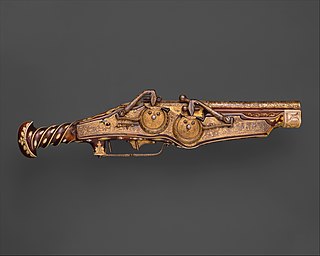 W
WA double-barreled wheellock pistol was crafted by German gunsmith Peter Peck for Charles V in 1540. It is one of the oldest surviving European pistols. It is in the collection of the Metropolitan Museum of Art.
 W
WA duelling pistol is a type of pistol that was manufactured in matching pairs to be used in a duel, when duels were customary. Duelling pistols are often single-shot flintlock or percussion black-powder pistols which fire a lead ball. They were made in identical pairs to put both duelists on the same footing. Not all fine pairs of pistols are actual duelling pistols, though they may be called so.
 W
WThe Enfield Revolver was a self-extracting British handgun designed and manufactured at the government-owned Royal Small Arms Factory in Enfield, initially in the .476 calibre.
 W
WThe Pistolet modèle 1786 was a flintlock Navy pistol, in service in French units from 1786 and made until 1806, when it was superseded by the Pistolet modèle An XIII.
 W
WThe Frontier Bulldog, Western Bulldog, or American Bulldog is a 5-shot, .44 S&W American, double action, 2+1⁄2-inch barrel snubnosed revolver made by the Belgian firm J.B. Rongé & Sons of Liège, and primarily sold in the United States, from late 1870s to 1914, through the Sears-Roebuck and Montgomery Ward mail-order catalogs. The base price was US$3.80, compared to $12 for a Smith & Wesson Model 3 Double Action in the same calibre. It is a copy of the Philip Webley & Son of Birmingham British Bull Dog revolver.
 W
WThe model 1805 U.S. Marshal "Harper's Ferry" flintlock pistol, manufactured at the Harpers Ferry Armory in Virginia, was the first pistol manufactured by an American national armory. It was the standard handgun of the US dragoons during the War of 1812.
 W
WThe howdah pistol was a large-calibre handgun, often with two or four barrels, used in Africa and India from the beginning of the nineteenth century, and into the early twentieth century, during the British Empire era. It was intended for defence against lions, tigers and other dangerous animals that might be encountered in remote areas. Multi-barreled breech-loading designs were later favoured over contemporary revolvers, due to their higher velocity and faster reloading potential.
 W
WKerr's Patent Revolver was an unusual 5-shot single-action revolver manufactured from 1859 to 1866 by the London Armoury Company. It was used by Confederate cavalrymen during the U.S. Civil War. Seven of these revolvers were held by the New Zealand Colonial Defence Force in 1863 and were issued to the famous Forest Rangers at the start of the campaign to push Maori rebels out of the Auckland province. It is easily recognized by its side-mounted hammer.
 W
WThe Lancaster Pistol was a multi-barrelled handgun produced in England in the mid-late 19th century, chambered in a variety of centrefire pistol calibres—chiefly .38 S&W, .450 Adams, .455 Webley, and .577 inch. The designer, London gunsmith Charles Lancaster, began his career in 1847 as an apprentice to his father, Charles Sr. During the 1850s he invented oval bore rifling and the gas check bullet.
 W
WIn 1854, Frenchman Eugene Lefaucheux introduced the Lefaucheux Model 1854, notable as being the first revolver to use self-contained metallic cartridges rather than loose powder, pistol ball, and percussion caps. The M1854 model was a single-action, pinfire revolver holding six rounds. It was a French military revolver chambered for the 12 mm pinfire cartridge, based on a design by Casimir Lefaucheux. The M1854 revolver spawned numerous variants, some of which were produced under license in other countries. It was widely exported during the 1860s and sold as both a military and civilian sidearm with either a short or long barrel. Most military models were produced only with single-action whereas civilian models were made primarily with double action.
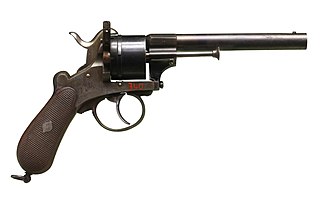 W
WThe Lefaucheux M1858 was a French military revolver developed for the navy, chambered for the 12 mm pinfire cartridge, and based on a design by Casimir Lefaucheux and his son, Eugene. The 1854 model was the first metallic-cartridge revolver adopted by a national government; the 1858 was the first variant fielded It was first issued in 1858 by the French Navy, and though never issued by the French Army, it was used in limited numbers by the French Cavalry during their 1862 deployment to Mexico. The 1858 was later upgraded in the late 1860s as the Lefaucheux de Marine 1870. It was accepted by the French Navy, but only 150 copies were delivered by 1872. Models of the 1858 were also purchased by Spain, Sweden, Italy, Russia, and Norway. Most were produced either at the state arsenal Manufacture d'armes de Saint-Étienne (MAS), Liège, Belgium, or local producers under license. The revolver was sold to the civilian market as well. Most military models were produced only with single-action, whereas civilian models were made primarily with double action.
 W
WThe LeMat revolver was a .42 or .36 caliber cap & ball black powder revolver invented by Jean Alexandre LeMat of New Orleans, which featured an unusual secondary 20 gauge smooth-bore barrel capable of firing buckshot. It saw service with the armed forces of the Confederate States of America during the American Civil War of 1861–65 and the Army of the Government of National Defense during the Franco-Prussian War.
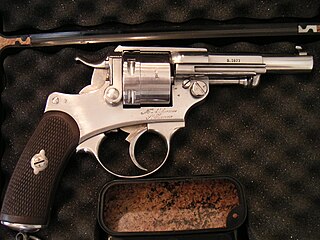 W
WThe service revolver model 1873 Chamelot-Delvigne was the first double-action revolver used by the French Army. It was produced by Manufacture d'armes de Saint-Étienne from 1873 to 1887 in about 337,000 copies. Although replaced by the Modele 1892 revolver, it was nevertheless widely used during the First World War, and issued to reserve units in 1940. The Resistance made widespread use of it during the Occupation.
 W
WThe Model 1892 revolver is a French service revolver produced by Manufacture d'armes de Saint-Étienne as a replacement for the MAS 1873 revolver. It was the standard issue sidearm for officers in the French military during the First World War.
 W
WThe pepper-box revolver or simply pepperbox is a multiple-barrel firearm, mostly in the form of a handgun, that has three or more gun barrels in a coaxially revolving mechanism. Each barrel holds a single shot, and the shooter can manually rotate the whole barrel assembly to sequentially index each barrel into alignment with the lock/hammer, similar to operating a revolver cylinder.
 W
WThe Pistolet modèle 1733 was a flintlock cavalry pistol, in service in French units from 1733.
 W
WThe Pistolet modèle An IX was a flintlock cavalry pistol, in service in French units from 1801.
 W
WThe Pistolet modèle An XIII was a flintlock cavalry pistol, in service in French units from 1806.
 W
WQueen Anne pistols are a type of flintlock pistols distinguished by the lockplate being forged in one piece with the breech and the trigger plate. They are usually a breech-loading design known as a turn-off pistol. Possibly first made in England, they came in fashion in England during the reign of Anne, Queen of Great Britain, hence the name. Though made in all sizes up to carbine, they were usually made in the size range known as coat pocket pistols or coat pistols, easy to conceal on one's person. A small version, known as a Toby or muff pistol, was able to be concealed in a smaller pocket or a ladies' hand warmer muff.
 W
WThe Remington-Beals Model Revolvers along with subsequent models and variations were percussion revolvers manufactured by Eliphalet Remington & Sons in .31 (Pocket) .36 (Navy) or .44 (Army) caliber, used during the American Civil War, and was the beginning of a successful line of medium and large frame pistols. They are commonly, though inaccurately, referred to as the Model 1858 due to the patent markings on its New Model barrels, "PATENTED SEPT. 14, 1858/E. REMINGTON & SONS, ILION, NEW YORK, U.S.A./NEW MODEL."; although wide scale production did not start until 1861.
 W
WRemington Model 1875 Single Action Army was a revolver by E. Remington & Sons. It was based upon the successful New Model Army with both revolvers having the same size, appearance, and the removable cylinder. The new 1875 Remington differed mainly from the older 1858 percussion model by having a bored through cylinder chambered for metallic cartridges. Thus, in 1875, Remington entered the cartridge revolver market with this big-frame, army style revolver, intended to compete with the Colt Peacemaker. Ordinary citizens and Old West lawmen alike recognized the sturdy quality of the new Remington revolvers. This design was followed by the Model 1888 and the Model 1890.
 W
WThe Remington Model 1890 New Model Army was a revolver by Remington Arms. It was based on the successful Remington Model 1875 and the lesser known Model 1888 with both revolvers having the same size, appearance, and the removable cylinder. The 1890 Remington single-actions kept the solid frame and similar styling of the 1875 model, but lacking the large web under the ejector rod housing and equipped with checkered rubber grips. Like the 1875 model, the 1890 was suitably made for metallic cartridges, but only issued in .44-40 caliber.
 W
WThe Ruger Old Army is a black-powder percussion revolver introduced in 1972 by the Sturm, Ruger company and manufactured through 2008. Models were made with a 7.5" and a 5.5 inch barrel.
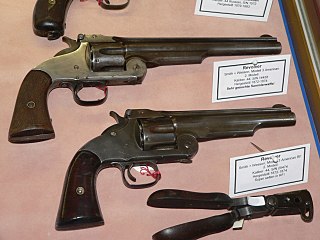 W
WThe Smith & Wesson Model 3 is a single-action, cartridge-firing, top-break revolver produced by Smith & Wesson (S&W) from around 1870 to 1915, and was recently again offered as a reproduction by Smith & Wesson and Uberti.
 W
WA Starr revolver is a double-action revolver which was used in the western theater of the American Civil War until the U.S. Ordnance Department persuaded the Starr Arms Co. to create a single-action variant after discontinuation of the Colt. The company eventually complied, and the Union acquired 25,000 of the single-action revolvers for $12 each. However, the price paid by the government for the DA army revolver was $25. The State of Ohio purchased 500 of the .36 Caliber Navy version for $20 each.
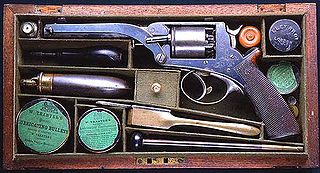 W
WThe Tranter revolver was a double-action cap & ball revolver invented around 1856 by English firearms designer William Tranter (1816–1890). Originally operated with a special dual-trigger mechanism later models employed a single-trigger mechanism much the same as that found in the contemporary Beaumont–Adams revolver.
 W
WThe Walch Revolver is a .36 caliber cap and ball black powder revolving action handgun, designed by Walch Firearms & Co. The revolver was patented in 1859 by John Walch.